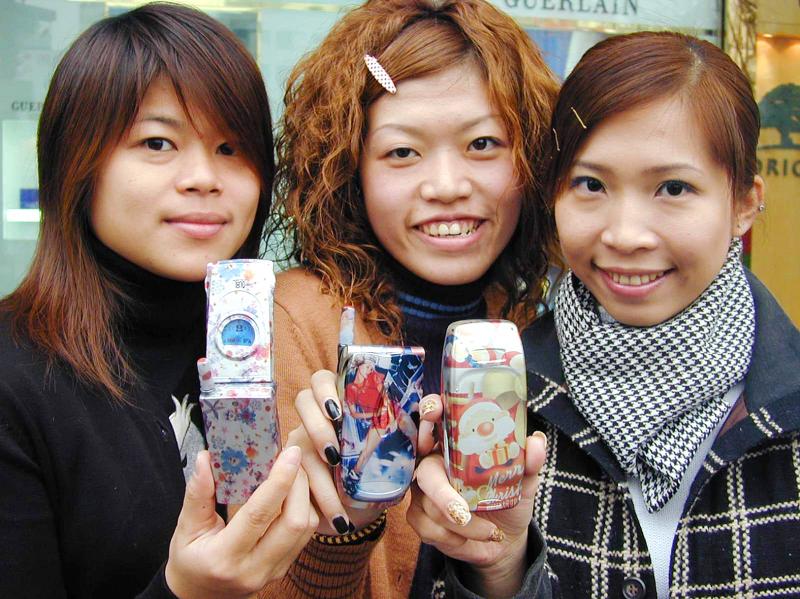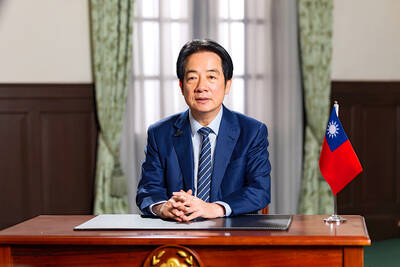Feb. 21 to Feb. 27
By the end of February 2000, Taiwan’s mobile phone users had surpassed those with landlines. It was a quick surge for the industry, as just three years prior the coverage rate was 7 percent, according to the 2001 book Covering the Sky with One Hand: The Telecommunications Wars between the Four Heavenly Kings (隻手遮天: 大哥大四天王的電信大戰) by Peng Shu-fen (彭淑芬).
By the end of 2000, it was at 75 percent.

Photo: Chang Ching-ya, Taipei Times
“Although the battle for the mobile phone market was fierce, compared to other foreign markets, [Taiwan’s] developed quite rationally,” Peng writes. “Unlike Hong Kong, for example, there was no bloody price war with no regard to costs. But even though that didn’t happen here, the competition still greatly drove down phone fees.”
The trigger to these events was the government’s opening of the cell phone market to private operators in 1997. Eight participants entered the initial fray: Far EasTone Telecommunications Co (遠傳), Mobitai Communications Co (東信), Transasia Telecommunications Inc (泛亞), Chung Hwa Telecom Co (中華), KG Telecommunications Co (和信), Tung Jung Telecom (東榮) and Taiwan Mobile Co (台灣大哥大). Tung Jung was the first to fall, bought out by KG in December 1998.
By the time of the book’s writing, Taiwan’s cell phone fees fell to among the lowest in the world. The competition also drove up customer care and service quality, leading Peng to conclude that the consumers were the biggest winners of this war. Peng added that the voice-calling market was saturated, and with the advent of 2.5G Internet the next step would be moving toward data transmission.

Photo courtesy of Wikimedia Commons
EXCLUSIVE COMMODITY
Before 1997, the Directorate General of Telecommunications had a monopoly over phone usage in Taiwan. Cell phones were extremely expensive — one could cost over NT$100,000. Even if you had the cash, there were long lines to obtain a phone number — the waiting list was up to about 1 million people by 1997. If you were desperate, you could buy a number off someone for as much as NT$50,000.
As an alternative, private companies tried to promote the CT2 system, a short-range mobile phone that used terrestrial base stations. People were excited and tempted by the companies’ inflated promises, paying in advance to reserve their spot and even hoping to run their own mini-operation through purchasing a costly personal base station.
This experiment ended in disappointment due to the limited range of the stations (a few hundred meters) and other technical difficulties such as the phone not working if one was moving too quickly. The users quickly returned their devices and the venture crashed.
The government finally passed the Telecommunications Act in July 1996, which aimed to open up the market to private businesses. The Directorate’s sales and business arm was separated into Chunghwa Telecom, with the goal of eventually becoming a private company (it made the transition in 2005).
The race was on. Taiwan Mobile started rolling out deals a month before the market opened, and reportedly had 15,000 customers signed up by opening day. The companies got innovative to compete against each other, offering all sorts of deals, special contracts and putting great effort into advertising.
There was still a gender balance in cell phone use at the beginning. A 1998 report by the Nielsen Corporation showed that 37 percent of men between the ages of 15 and 60 used a cell phone, while only 14 percent women did, although 20 percent expressed a desire to get one soon.
The report also found two main groups of users: those with higher incomes who wore the phone on their waist as a status symbol, and people such as salesmen who actually needed them for their jobs. It added that it would soon tap into the youth market.
Today only three of the original eight remain — Taiwan Mobile purchased Mobitai in 2004 and TransAsia in 2008, while KG was bought out by Far EasTone in 2010.
SHOWING OFF
By the end of February 2000, there were an estimated 12,180,000 cell phone users in Taiwan.
Of course, such a sudden proliferation of the technology brought problems, many of which persist today. Phone etiquette was a big issue, as discussed in the 2000 “Study on Improper Use of Cell Phones in Public Spaces (台灣公共空間內使用大哥大不當行為之探討) by Tseng Shih-yuan (曾士原).
Everyone who had one wanted to show off their new gadget, and they hung them by their waists and talked on them as much and as loud as they could, Tseng writes. It was not uncommon to see people slamming their large, seemingly indestructible phones onto the table as they arrived at a restaurant, yakking on them loudly throughout the course of the meal.
“If talking on the cell phone itself has become a fashionable leisure activity, or an action that one just can’t help showing off to the public, this means that our [already noisy] public spaces will have no chance of becoming quieter.” Tseng writes.
Before authorities clamped down on the practice, phones rang during class, in the library or at movie theaters — one interviewee said that he had heard at least 10 phones ringing during a screening.
This extreme visibility and showing off definitely hastened the popularity of mobile phones, Tseng writes.
“If someone calls you all the time, that suggests that your ability, importance and popularity are top notch,” Tseng writes. “When a cell phone becomes the symbol of how important you are, then even those who don’t actually need cell phones would be eager to have one too.”
Two decades later, this behavior has waned significantly, though it still persists.
Taiwan in Time, a column about Taiwan’s history that is published every Sunday, spotlights important or interesting events around the nation that either have anniversaries this week or are tied to current events.

This month the government ordered a one-year block of Xiaohongshu (小紅書) or Rednote, a Chinese social media platform with more than 3 million users in Taiwan. The government pointed to widespread fraud activity on the platform, along with cybersecurity failures. Officials said that they had reached out to the company and asked it to change. However, they received no response. The pro-China parties, the Chinese Nationalist Party (KMT) and Taiwan People’s Party (TPP), immediately swung into action, denouncing the ban as an attack on free speech. This “free speech” claim was then echoed by the People’s Republic of China (PRC),

Most heroes are remembered for the battles they fought. Taiwan’s Black Bat Squadron is remembered for flying into Chinese airspace 838 times between 1953 and 1967, and for the 148 men whose sacrifice bought the intelligence that kept Taiwan secure. Two-thirds of the squadron died carrying out missions most people wouldn’t learn about for another 40 years. The squadron lost 15 aircraft and 148 crew members over those 14 years, making it the deadliest unit in Taiwan’s military history by casualty rate. They flew at night, often at low altitudes, straight into some of the most heavily defended airspace in Asia.

Many people in Taiwan first learned about universal basic income (UBI) — the idea that the government should provide regular, no-strings-attached payments to each citizen — in 2019. While seeking the Democratic nomination for the 2020 US presidential election, Andrew Yang, a politician of Taiwanese descent, said that, if elected, he’d institute a UBI of US$1,000 per month to “get the economic boot off of people’s throats, allowing them to lift their heads up, breathe, and get excited for the future.” His campaign petered out, but the concept of UBI hasn’t gone away. Throughout the industrialized world, there are fears that

The Democratic Progressive Party (DPP) controlled Executive Yuan (often called the Cabinet) finally fired back at the opposition-controlled Legislative Yuan in their ongoing struggle for control. The opposition Chinese Nationalist Party (KMT) and Taiwan People’s Party (TPP) acted surprised and outraged, but they should have seen it coming. Taiwan is now in a full-blown constitutional crisis. There are still peaceful ways out of this conflict, but with the KMT and TPP leadership in the hands of hardliners and the DPP having lost all patience, there is an alarming chance things could spiral out of control, threatening Taiwan’s democracy. This is no